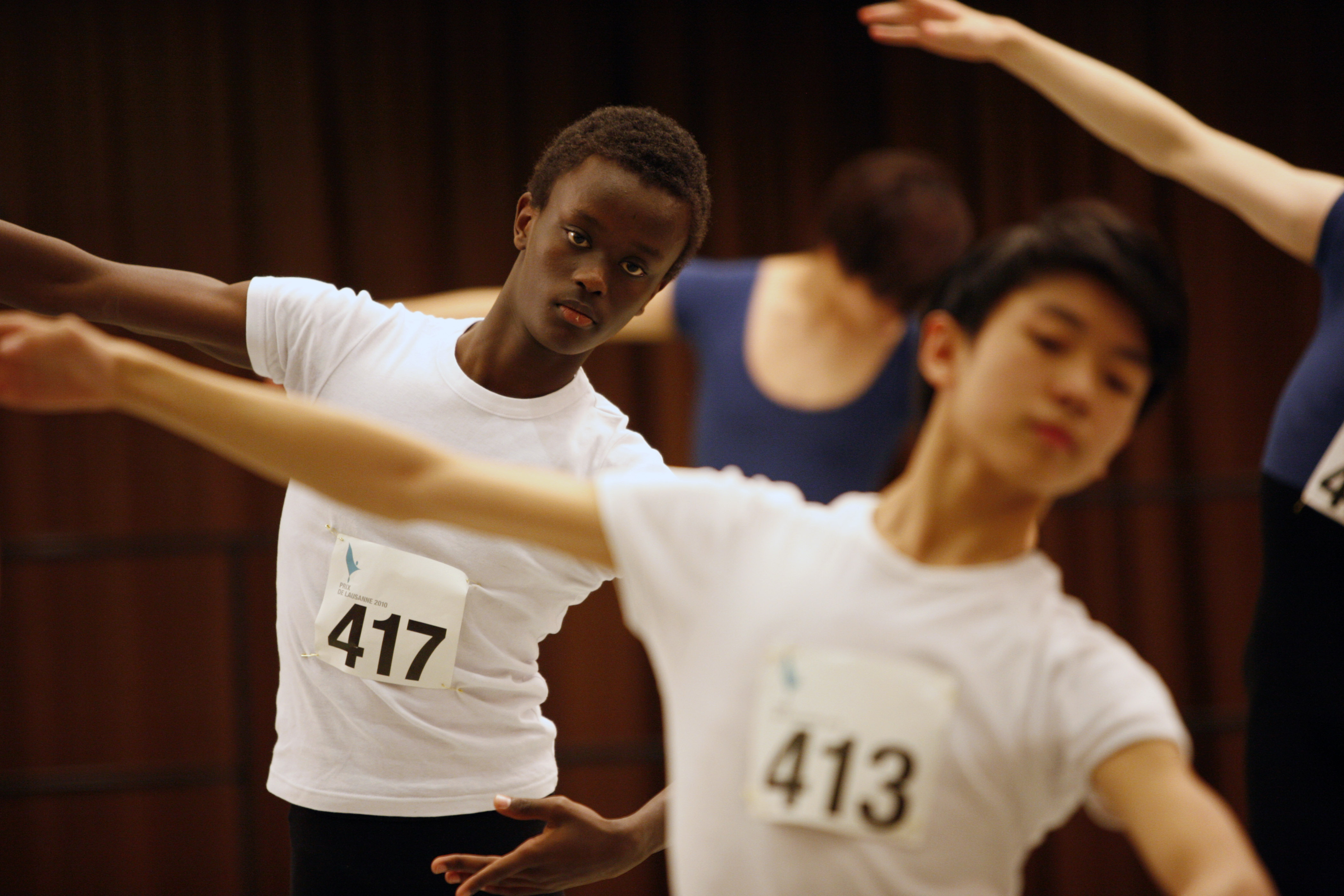
Boys take the lead at Prix de Lausanne

Among the young dancers warming up for the Prix de Lausanne ballet competition, you may have been surprised to see – for the very first time – more boys than girls.
Another first this year was the fact that two Swiss have been selected for the prestigious competition, evidence that the home dance scene is taking a leap forward.
It was a hive of activity in the warm up area of Beaulieu Theatre in Lausanne, where the competition was taking place. The older girls had just finished their contemporary class, and the boys were warming up – with great jumps and long stretches of limbs.
In all, 70 dancers from all over the world and aged between 15 and 18, gathered in Lausanne for the week-long Prix, which started on Monday.
This year saw more boys – 36 to the girls’ 34 – taking part for the very first time in the event’s 38-year history.
“At the end of the selection round last October it was a total surprise to us to see that the results of the calculations were that there would be more boys than girls,” Patricia Leroy, the Prix de Lausanne’s Secretary General, told swissinfo.ch.
“We don’t really know if there is any particular reason for that, we’ll have to wait a few more years to discover if this is a trend or just a coincidence. But it is wonderful.”
Billy Elliot effect?
Among those warming up was Prix scholarship winner Lewis Turner, aged 17, who trains at the Elmhurst School for Dance, which is associated with the Birmingham Royal Ballet. He saw the higher turnout of boys as a positive sign.
“I think it can only be a good thing for the art form, if that’s a representation that more boys are getting involved with ballet and dance,” he said.
“I read somewhere that it’s the Billy Elliot trend coming through, I don’t know whether that can be said or not, but if so, it can only be good,” Turner added, referring to the British film in which a boy from a mining village lives his dream of becoming a ballet dancer.
One boy who was particularly happy to be at the competition was 18-year-old Philip Handschin from Basel, one of two Swiss hopefuls at the Prix – the other being Alexandra Valavanis, 15, from Zurich, who was a Prix finalist.
“I’m excited to be here, a lot of people, good staff,” he told swissinfo.ch.
Swiss boost
His Prix video blog showed how he had been enjoying the contemporary classes, which were held along with classical lessons and dress rehearsals in the run-up to Sunday’s final. But the Beaulieu Theatre’s slightly slanted stage did take a bit of getting used to, he said.
Leroy said that the presence of the two Swiss – Handschin is at the Basel Theatre Ballet School and Valavanis at the Zurich Opera House’s ballet school – would give a boost to Swiss dancing.
“There are very good ballet schools in Switzerland, but sometimes the infrastructure did not allow those schools to give such a complete education as the Prix de Lausanne partner schools do,” she said.
“This is a very good sign that conditions for training and dancing in Switzerland are really improving.”
Potential
The Prix de Lausanne is different from other competitions, Leroy explained, because it rewards potential rather than present accomplishment. For this reason, the judges sit in on classes and practice during the week, to help them select the finalists.
In all, 20 candidates are selected for the final, dancing two variations – one classical and one specially-devised contemporary.
Winners receive scholarships to join renowned partner ballet schools or gain an apprenticeship to companies such as the Hamburg Ballet John Neumeier or the Birmingham Royal Ballet.
This can act as a springboard for an international career. Big name winners of the past include the Royal Ballet’s Carlos Acosta and Alina Cojocaru. Even those who don’t make the final benefit from the exposure they have at the Prix, added Leroy.
There was much excitement, and a few nerves, among the young dancers. Whether concentrating in class or relaxing after a session – feet clad in moonboot-like shoes to keep these important dancing instruments warm – their passion for the art was clear. All spend six days a week training, with only Sunday free.
Ballet passion
Caitlin Stawaruk, 18, from Australia, another winner, studies at the Zurich Dance Academy. “The more I do ballet, the more challenges it gives me and when you succeed in a challenge it’s a really great feeling,” she told swissinfo.ch.
Stawaruk hopes to dance in a company one day and “perform for my family and friends, show them why I’ve been away from home for so long and show everyone what I love to do”.
Her fellow academy dancer, the Japanese Aya Baba, also 18, would like to stay in Europe, a dream shared by many of her compatriot dancers – who, numbering 16, make up the largest country contingent.
“I like being here… in Europe more people like to see dance than in Japan,” she said.
For his part, the young Englishman Turner said ballet was a way of expressing his joy, feelings and the music.
One day he hopes, as many, to be a principal dancer – essentially a ballet company’s star – although he knows that not everyone can make it in the tough dance world.
“But just the buzz of the stage, I think that’s what everyone craves, so just being on stage is always going to create that experience for everyone.”
Isobel Leybold-Johnson in Lausanne, swissinfo.ch
The Prix de Lausanne was set up in 1973 by Philippe and Elvire Braunschweig as a competition for young dancers.
The 38th Prix de Lausanne 2010 ran from January 26-31 at the Beaulieu Theatre in Lausanne.
Scholarship winners:
Cristian Emanuel Amuchastegui, Argentina
Mungamba Reina Francisco, Spain
Mariko Sasaki, Japan
Caitlin Stawaruk Australia
Aaron Sharratt, US
Christopher Evans, US
Lewis Turner, Britain
Contemporary prize: Lewis Turner
Audience prize: Cristian Emanuel Amuchastegui
Swiss prize: Alexandra Valavanis
The Prix contemporary choreographies have been specially created by two young and famous choreographers. This includes Cathy Marston, the British director of the Bern Ballet. She told swissinfo.ch via email that she was honoured to be at the Prix, and was also excited and curious to see how the young talents would perform her work.
Marston has created Caliban and Libera Me for both male and female candidates, plus Traces (girls) and Captain Alving (boys). “In my work I’m hoping to see thought, investigation and clear intention in the movement,” she said.
“There are some technical moments and ‘tricks’ but primarily I want to see that the dancers have considered where the movement is initiated – both physically and emotionally. I want them to make clear choices about how they perform the steps in terms of their relationship to the music, space and focus.
“In the longer term I hope these are challenges that might also feed into their more classical work and that learning these solos will open their minds to ballets that are being created today rather than centuries ago!”

In compliance with the JTI standards
More: SWI swissinfo.ch certified by the Journalism Trust Initiative































You can find an overview of ongoing debates with our journalists here . Please join us!
If you want to start a conversation about a topic raised in this article or want to report factual errors, email us at english@swissinfo.ch.